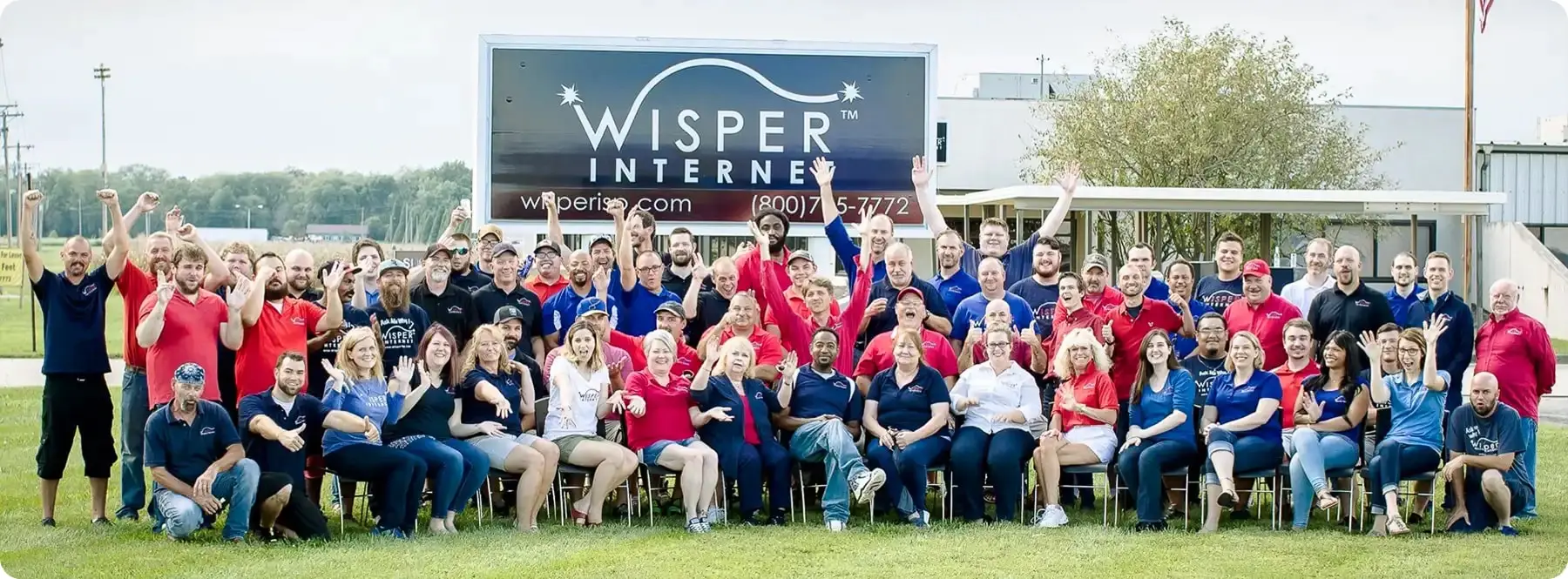Challenge: Outgrowing an in-house system that was a game-changer at the time
Wisper Internet has been delivering fixed wireless and fiber connectivity to underserved communities across the Midwest for over two decades. As one of the early players in the U.S. WISP space, the company built much of its technology infrastructure from the ground up.
Wisper’s in-house system served them well in the early years. It provided full control, custom workflows, and centralized everything from provisioning to customer management.
But as the broadband industry evolved, new vendors appeared, and third-party platforms improved, Wisper’s tech foundation began to show its age.
Over time, Wisper’s once-efficient all-in-one solution became fragmented. The billing module had been offloaded to a separate system, while the original OSS remained in place. This dual-platform setup created real operational friction.
The lack of a unified system with integrations not only slowed down internal workflows but also made training and onboarding new agents inefficient. Staff were required to learn multiple tools, increasing time, workload, and the risk of errors.
Wisper’s leadership knew a major transformation was needed. But let’s be honest – one of the hardest parts wasn’t just technical.
It was “THE CHANGE ASPECT” itself. Sound familiar?
- What will your customers think when you suddenly introduce something new after they have run the same system for a long time?
- Will your team adopt it easily?
- How long will it take to retrain staff, adopt workflows (if needed), and get everyone comfortable again?
And perhaps the biggest question of all: how do you make the transition smooth, with the right partner who actually supports you through it?
For ISPs facing these same questions, Splynx provides a step-by-step guide on switching ISP billing and OSS software.
Finding the right fit: A partner that could help Wisper Internet scale without breaking the bank
Once they decided to move on from their in-house system, Wisper’s team didn’t jump straight into Splynx. They did what any experienced provider would — they looked far and wide.
- What else was out there?
- Were there better, all-in-one platforms?
- Could someone else offer the depth and flexibility they needed?
But there was a catch – the cost. Many platforms were priced per subscriber, per admin, per mobile app user… and when scaled to Wisper’s size, the numbers didn’t add up.
Then, during a conference, Luke Phillips, VP of Solutions and Innovation at Wisper Internet, sat down with Alex Vishnyakov, Splynx CEO, and instead of the usual demo or sales pitch, they had a real conversation: about scalability, about vendor lock-in, about the reality of running a growing ISP without blowing up your tech budget.
For Wisper, it wasn’t just about features — it was about flexibility and future-proofing.
Could this system grow with them?
Would they be able to build on it, customize it, and make it theirs?
The answer was YES.
From there, Splynx quickly distinguished itself as the platform that could meet Wisper’s scalability needs while keeping costs realistic. The open API, strong data access capabilities, and flexible deployment were key differentiators.
Implementation: Phased rollout and deep collaboration
No matter how confident you are in the platform, the first move is always the hardest. Wisper chose to begin with a phased rollout. Rather than migrate everything at once, they decided to start by moving just the billing functionality.
During the initial integration phase, which focused on billing operations and payment processing, the Splynx team also delivered integration with the U.S. payment provider Paymentus.
This integration introduced omnichannel payment processing capabilities, including guest payment links that can be sent directly to customers via SMS. Customers can make instant payments without needing to log into the customer portal, significantly reducing friction in the payment process.
In addition, the integration supports IVR (Interactive Voice Response) functionality, allowing customers to call a dedicated phone line to check their account balance, make payments using a credit or debit card, and receive confirmations – all fully synced with Splynx in real time. These self-service tools help to reduce the load on call center staff and improve CX.
Worried about timezone differences with the Splynx support team?
Wisper Internet was too. But when things got serious, those concerns quickly faded.
Wisper’s team also emphasized the value of Splynx’s development responsiveness and willingness to build features in partnership – a key differentiator compared to other vendors.
Timmothy Vermeulen, Information Systems Product Owner at Wisper Internet, also added:
In addition to billing and payments, the first phase included integrating Preseem with Splynx to support network visibility and performance optimization.
Early results after phase one of Splynx implementation
Even though Wisper has completed only the first phase of its Splynx implementation – migrating billing – the impact has already been significant across multiple operational areas. With RADIUS and ticketing modules planned next, the early results are promising:
1. Operational visibility
One of the most noticeable improvements has been the ability to trace and resolve customer issues faster, thanks to detailed system data and complete account activity logs.
This visibility empowers agents to resolve problems immediately without callbacks or escalation.
2. Billing automation
Wisper Internet activated approximately 90% of Splynx’s billing automation features, including recurring billing, auto-pay runs, invoice reminders, SMS/email scheduling, and more. These automations now run smoothly in the background, saving time while improving customer communication.
3. Training & onboarding
Training new team members also became easier. Previously, training new staff meant introducing them to a bunch of different tools and platforms. With Splynx acting as the unified interface, onboarding is now faster, simpler, and more scalable.
4. Customer portal
On the customer side, Splynx enabled a leap forward. Wisper’s previous customer portal offered only the most basic functionality. With Splynx, customers now have access to a modern self-service interface where they can view their plans, usage, invoices, and make payments easily.
5. Real-time insights and access to needed data
With the previous system, the Wisper Internet team relied on daily batches that got updated at night, which often meant that issues wouldn’t surface until the next day. Splynx introduced real-time data flows, allowing the Wisper team to detect problems and respond immediately.







